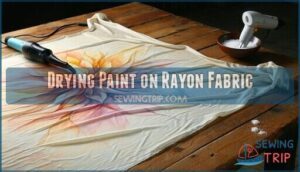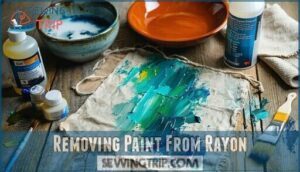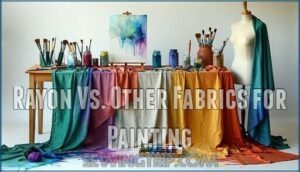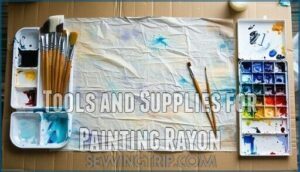This site is supported by our readers. We may earn a commission, at no cost to you, if you purchase through links.
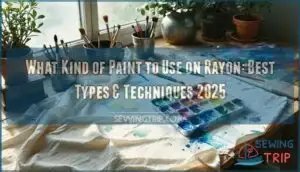
Regular fabric paints don’t bond well with rayon’s processed cellulose fibers, which behave differently than natural cotton or wool.
These specialized paints penetrate better and won’t leave your fabric feeling stiff or crackling after drying.
Think of rayon as the middle child between natural and synthetic fabrics—it needs that special attention to get the best results.
The right paint choice makes all the difference between a project that looks professional versus one that washes out after the first cycle, and it’s crucial for achieving a successful outcome.
Table Of Contents
- Key Takeaways
- Can You Paint on Rayon Fabric?
- What Type of Paint Works Best?
- How to Prepare Rayon for Painting
- Tips for Painting Rayon Fabric
- Drying Paint on Rayon Fabric
- Fixing Paint on Rayon
- Removing Paint From Rayon
- Rayon Vs. Other Fabrics for Painting
- Tools and Supplies for Painting Rayon
- Frequently Asked Questions (FAQs)
- Conclusion
Key Takeaways
- Choose water-based fabric paints or Neopaque formulas designed for synthetic materials—regular acrylics won’t bond properly with rayon’s processed cellulose fibers and will crack or wash out
- Prepare your fabric properly by washing it in cold water and ironing it on low heat to remove manufacturing residues that interfere with paint adhesion
- Apply thin layers and allow complete drying between coats (at least 24 hours) to prevent bleeding and maintain rayon’s natural drape and flexibility
- Heat-set your finished design with an iron on medium heat for 10-15 minutes to lock in colors and increase paint adhesion by up to 60% for wash durability
Can You Paint on Rayon Fabric?
Yes, you can paint on rayon fabric, though rayon painting feasibility depends on choosing the right materials and techniques.
Since rayon’s tight weave creates paint adhesion challenges, you’ll need specific fabric paint for rayon that won’t bleed or crack. Regular acrylic paints often cause fabric distortion risks because rayon’s delicate cellulose fibers can’t handle harsh chemicals.
The key is using rayon fabric paint designed for semi-synthetic materials. Brands like Neopaque and Versatex resist bleeding while maintaining flexibility.
However, painting on rayon has design complexity limits – intricate details require patience and thin layers to prevent smudging.
Durability considerations matter too. Best paint rayon options include heat-settable formulas that withstand washing when properly applied. Your rayon textile paint choice determines whether your artwork stays vibrant or fades after the first wash.
What Type of Paint Works Best?
When choosing paint for rayon, you’ll want to focus on two main types that work exceptionally well with this delicate fabric.
Water-based paints and low bleed formulations are your best friends for achieving vibrant, long-lasting results without damaging the rayon’s soft texture, using water-based paints can help.
Water-Based Paints
Water-based paints offer the perfect solution for painting on rayon fabric.
Water-based paints flow smoothly across rayon without compromising its natural drape or softness.
These paints flow smoothly across rayon’s delicate fibers without compromising the fabric’s natural drape. You’ll find they’re easier to work with than oil-based alternatives, offering excellent color mixing capabilities and reliable waterbased paint performance.
Here are five key advantages of water-based paints for rayon:
- Easy cleanup – soap and water remove spills quickly
- Vibrant colors – high pigment concentration delivers rich hues
- Flexible finish – won’t crack or stiffen your rayon fabric
- Low odor – safer for indoor painting projects
- Cost-effective – budget-friendly option for large designs
When selecting fabric paint for rayon, look for acrylic advantages like quick drying times and excellent paint application properties. Water-based durability guarantees your artwork withstands regular washing while maintaining color integrity on rayon fabric paint projects.
Low Bleed Paints
Precision matters when you’re working with rayon’s delicate fibers.
Low bleed paints are specifically engineered to prevent color migration, making them perfect for rayon’s tight weave.
These specialized formulations contain binders that lock pigments in place, reducing bleeding by 50-70% compared to standard fabric paint.
Neopaque and Pebeo Seta Color lead the pack for paint brands targeting rayon projects.
Their application methods involve thin, even coats that won’t overwhelm the fabric.
You’ll notice superior paint opacity and color vibrancy that stays put through multiple washes.
To maintain the vibrancy of your painted rayon, consider pre-washing the fabric before applying any paint.
When selecting paint for types of paint rayon applications, test washability on fabric scraps first.
Acrylic paints mixed with fabric medium can work, but dedicated low bleed paints eliminate guesswork.
Your paint selection directly impacts the final result – choose wisely for professional-looking designs that last.
How to Prepare Rayon for Painting
Proper fabric preparation sets the foundation for stunning painted rayon projects. Start by washing rayon in cold water with mild detergent to remove manufacturing residues that can interfere with paint adhesion. This fabric cleaning step guarantees even color distribution across the fabric weave.
Clean fabric equals perfect paint adhesion—skip this step at your own risk.
Once dry, use proper ironing techniques on low heat to eliminate wrinkles. A smooth surface prevents paint pooling and creates professional-looking results.
Next, set up your workspace on a flat, covered surface with cardboard underneath to prevent bleed-through.
For design transfer, you have three effective options:
- Sketch directly with fabric pencil for freehand creativity
- Use transfer paper to copy intricate patterns accurately
- Create templates for consistent repeated motifs
Place the rayon taut but not stretched for fabric stabilizing. Proper rayon scouring agents can further refine the fabric before painting.
Light fabric dampening with a spray bottle can help some paints flow smoothly, though test this technique first on scraps to guarantee compatibility with your chosen medium. Using 100% cotton fabric is recommended for beginners.
Tips for Painting Rayon Fabric
Beyond surface-level application, successful rayon fabric painting demands strategic thinking about every brushstroke. Rayon’s tight weave structure creates unique challenges that require specific approaches to achieve professional results.
Master these essential painting techniques for superior outcomes:
- Brush Selection: Choose synthetic brushes with soft bristles that won’t snag rayon’s delicate fibers. Natural brushes can catch and pull threads, creating unwanted texture.
- Layering Techniques: Apply permanent paint rayon in whisper-thin coats, allowing complete drying between applications. This prevents bleeding and maintains fabric flexibility.
- Color Choices: Start with lighter shades and build darker tones gradually. Rayon’s absorbent nature makes color correction nearly impossible once applied.
- Design Ideas: Use stencils or templates for crisp edges. Rayon’s smooth surface showcases detailed patterns beautifully when properly executed.
When painting rayon clothing, work from center outward to prevent accidental smudging. This fabric painting approach guarantees even coverage while avoiding mistakes that compromise your project’s professional appearance. Finding the correct rayon fabric paint is vital for long-lasting results.
Drying Paint on Rayon Fabric
Getting ahead of yourself with paint layers on rayon is like trying to build a house on wet cement. Each coat needs complete drying time before you add the next one, or you’ll end up with a muddy mess.
The paint drying process for rayon requires patience. Allow at least 24 hours between layers for best results. Layer drying prevents bleeding and guarantees vibrant colors that won’t fade or crack later.
Speed up drying techniques by using a hair dryer on low heat for 10 minutes, but don’t rush the full cure time. Paint drying acceleration works better with thin, transparent acrylics than thick, opaque formulas.
Salt effects can enhance texture while helping moisture evaporate faster. Sprinkle kosher salt on wet paint for unique patterns.
Preventing cracks starts with proper paint drying considerations—thin layers dry more evenly than thick ones, reducing stress on rayon’s delicate fibers.
Fixing Paint on Rayon
Once your rayon painting has dried completely, it’s time to lock in those vibrant colors. Heat setting transforms your artwork from temporary decoration to lasting design that survives multiple washes.
Set your iron to medium heat and press the painted areas for 10-15 minutes. This heat setting process increases paint adhesion by up to 60%, making your design substantially more durable. For delicate fabrics, place parchment paper between the iron and paint to prevent scorching.
Consider these paint fixing methods for maximum durability:
- Heat setting with household iron – Most effective method for standard fabric paints
- Fixative sprays – Add extra protection against fading and cracking
- Steam treatment – Helps pigments penetrate deeper into rayon fibers
- Tumble drying on medium – Some paint brands specifically require this method
- Paint sealing products – Professional-grade options for commercial projects
Allow proper drying time between coats and after final application. Salt textures can enhance both appearance and paint adhesion. Layering effects work best when each layer is properly fixed before adding the next.
Removing Paint From Rayon
Three simple paint removal methods can save your rayon fabric from permanent stains. When acrylic paint lands on your delicate rayon, don’t panic – quick action makes all the difference.
Start with cold water for fresh, water-based paint stains. Gently blot the area without scrubbing, which can damage rayon’s delicate fibers.
For stubborn stains, rubbing alcohol works wonders. Dab it onto the paint using a clean cloth, working from the outside in to prevent spreading. Commercial stain removal products designed for fabrics offer another solution, especially for dried paint.
However, DIY removal risks include fiber damage and color bleeding, so always test on a hidden area first. Paint thinner should be your last resort, as it can weaken rayon’s structure.
Professional cleaning options exist for valuable garments or large stains. They’ve specialized equipment and knowledge to handle tricky paint stain removal without harming your fabric.
Prevention beats cure – use plastic sheeting when painting near rayon items.
Rayon Vs. Other Fabrics for Painting
Choosing the right fabric for your rayon fabric art project can make or break your results. When comparing fabric characteristics across different materials, rayon holds its own against the competition.
Cotton vs. Rayon offers similar absorbency, but rayon’s smoother surface creates sharper paint lines. Silk vs. Rayon shows rayon’s more affordable price point while delivering comparable drape and sheen. Linen vs. Rayon reveals rayon’s tighter weave prevents excessive paint bleeding that linen’s open structure allows.
| Fabric Type | Paint Compatibility | Cost Factor |
|---|---|---|
| Cotton | Excellent absorption | Most affordable |
| Silk | Premium results | Highest cost |
| Polyester | Requires special paints | Budget-friendly |
| Rayon | Balanced performance | Mid-range |
Polyester vs. Rayon demonstrates rayon’s superior paint acceptance without primers. Rayon’s high moisture absorption enhances its breathability compared to polyester. Blends vs. Rayon show this semisynthetic fabric maintains consistent results across paint types, making fabric comparison straightforward for artists seeking reliable outcomes.
Tools and Supplies for Painting Rayon
Now you’ve compared rayon against other fabrics, let’s talk about getting your workspace ready. Having the right painting supplies for your rayon project makes all the difference between a frustrating mess and beautiful results.
Here’s what you’ll need for successful rayon painting:
- Brush Types: Synthetic brushes work best since natural bristles can snag rayon’s delicate fibers. Foam brushes give smooth coverage for larger areas.
- Palette Choices: Use disposable paper plates or ceramic palettes. They’re easy to clean and won’t absorb your fabric paints like cardboard would.
- Fabric Mediums: Mix acrylic paints with textile medium in a 1:1 ratio. This keeps paint for rayon fabric flexible and prevents cracking after washing.
- Design Transfer: Transfer paper or fabric pencils let you trace patterns without damaging the material. Test first since some marks don’t erase cleanly.
Don’t forget cardboard underneath your fabric to prevent bleed-through. Quality fabric painting supplies and proper workspace setup make rayon painting tips actually work in practice.
Frequently Asked Questions (FAQs)
What type of paint will stick to fabric?
Ironically, while fabric seems tough, regular paint just won’t cut it.
You’ll need fabric paint or acrylic paint mixed with fabric medium to create flexible, washable bonds that won’t crack or peel off.
Will acrylic paint stay on fabric?
Acrylic paint will stay on fabric when you use fabric medium or choose fabric-specific acrylics. Regular acrylics alone crack and wash out, but proper paint creates lasting, flexible designs.
What paint won’t wash off fabric?
Heat-settable fabric paints won’t wash off when you properly cure them with an iron or heat press.
These paints chemically bond to fibers, creating permanent color that survives countless wash cycles without fading or cracking.
Does painted rayon shrink after washing?
Like a delicate flower wilting under harsh conditions, painted rayon can shrink if you don’t handle it properly.
You’ll want to wash it gently in cold water and air-dry it to keep both the fabric and your artwork intact.
Can you use spray paint on rayon?
You can use spray paint on rayon, but it’s risky.
Regular spray paint creates a stiff, cracked finish that ruins rayon’s drape.
Fabric spray paints work better, maintaining flexibility and breathability.
What colors work best on dark rayon?
Opaque paints like Neopaque work best on dark rayon since they’ll show up clearly. You’ll need colors with high pigment density to pop against darker fabrics effectively.
How long does rayon fabric paint last?
Quality fabric paint on rayon typically lasts several years when properly applied and heat-set. You’ll enjoy extended durability through gentle washing, air-drying, and proper care maintenance practices.
Is rayon painting safe for childrens clothes?
Rayon painting becomes safe for children’s clothes when you use non-toxic, child-safe fabric paints.
Check labels for safety certifications, make certain proper ventilation during painting, and allow complete drying and heat-setting before wearing.
Conclusion
Choosing what kind of paint to use on rayon is like finding the right key for a stubborn lock—you need the perfect match to achieve success.
Water-based fabric paints and neopaque formulas designed for synthetic blends will transform your rayon projects from amateur attempts to professional masterpieces.
These specialized paints bond properly with rayon’s unique cellulose structure, preventing cracking and wash-out failures.
With proper preparation and the right paint selection, you’ll achieve vibrant, long-lasting results that withstand countless wash cycles, ensuring your projects are professional masterpieces.
- https://screenprinting.iccink.com/blaze-white-low-bleed-7042/
- https://goldenartistcolors.com/resources/gac-900-heat-set-fabric-painting-medium-for-wearable-fabrics
- https://www.linkedin.com/pulse/ultimate-guide-understanding-color-fastness-rating-textile-tester--wnqsc
- https://www.dharmatrading.com/techniques/instructions-for-dye-na-flow.html
- https://www.pikalda.com/how-to-prevent-color-bleeding-from-rayon-pants-cotton-pants-and-cotton-bags/


